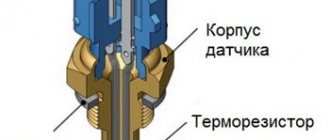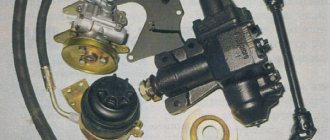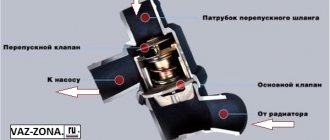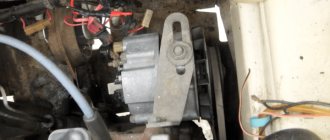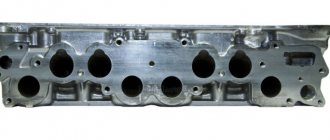The temperature of the internal combustion engine is a parameter that must be monitored especially carefully. Any temperature deviation from the values set by the engine manufacturer will lead to problems. At best, the car simply won't start. In the worst case, the car’s engine will overheat and jam so much that it will not be possible to do without expensive major repairs. This rule applies to all domestic passenger cars, and the VAZ 2107 is no exception. The thermostat is responsible for maintaining the optimal temperature regime on the “seven”. But it, like any other device in a passenger car, can fail. Is it possible for a car owner to replace it himself? Of course. Let's take a closer look at how this is done.
Thermostat Specifications
The cylindrical thermostat is equipped with three outlets for pipes - from the engine, from the radiator and to the circulation pump. You can get acquainted with the design in more detail by looking at the cross-section of the thermostat:
Thermostat VAZ 2107 cross-section
When the engine starts, coolant flows through the cylinder block and pump, once above 80 degrees is reached, the main valve shutter begins to allow antifreeze through the radiator. As the liquid temperature rises, the throughput of the valve increases, while at the same time the bypass valve closes the flow of antifreeze from the engine. The mark of 94 degrees is considered the maximum at which the liquid moves exclusively in a large circle (the main valve is open, the bypass valve is pressed tightly).
This is interesting: Windshield wiper motor - when is repair inevitable?
What will you need for replacement?
Before starting work, you need to make sure you have:
- New working part.
- Wrenches or socket heads with a ratchet and an extension “10” and “13”.
- Phillips and slotted screwdrivers (depending on the bolt heads of the worm clamps used).
- Containers with a volume of about 10 liters for coolant, preferably low and wide; a basin is perfect for this role. If you plan to reuse antifreeze, the container must be clean.
In most cases, up to three new clamps and at least 1–2 liters of antifreeze, similar to that poured into the car, will also be useful, because it is difficult to completely eliminate coolant loss when draining it. The following will help increase the convenience and efficiency of repairs:
- Socket wrench “7” or “8”, suitable for loosening and tightening clamps.
- Pliers that make it easier to remove the factory-installed band clamps on the Classic.
- A funnel for collecting coolant, for example, cut from a plastic bottle.
Often, replacing the thermostat on a Zhiguli is combined with pouring fresh antifreeze and installing new pipes or other parts of the cooling system. In this case, it is necessary to purchase the appropriate spare parts and coolant (total filling volume is 8.65 liters, that is, a little more than 9.5 kg).
Description, device and principle of operation.
The thermostat, also known as the “seven” thermostat, is a part that is a cylindrical container with three outlets for pipes. At the upper end of the part there is an inlet pipe from the engine, at the bottom there is an inlet pipe coming from the radiator, and the third outlet pipe is located on the top side. The thermostat device can be seen in more detail in the photo below.
If the engine is started “cold”, antifreeze passes through the cylinder block and the pump, the so-called small circle. This ensures quick warm-up of the engine. When the temperature reaches 80.6 to 81.5 degrees Celsius, the main thermostat valve begins to open, and the antifreeze begins to move in a large circle through the radiator. At the same time, the bypass valve gradually shuts off the antifreeze coming from the engine. When the temperature reaches 94 degrees, the valve opens to its maximum value, the coolant moves only in a large circle.
Checking the thermostat on VAZ 2105, 2107, 2108, 2109, 21099 cars
Let's check the functionality of the thermostat of the carburetor engine cooling system of VAZ 2105, 2107, 2108, 2109, 21099 cars. To check the thermostat and evaluate the correctness of its operation, you need to know its role in the car's cooling system and the principle of operation. The thermostat separates two circles of the cooling system (small and large) and has two valves: bypass and main. While the engine is warming up, coolant circulates through the small circle and the open thermostat bypass valve. The thermostat prevents it from mixing with the liquid from the large circle and thereby helps the engine warm up quickly.
More details about the operation of the thermostat on the page: “Thermostat operation diagram”
As it warms up (coolant temperature is about 87º - 2108, 2109 and 80-85º - 2105, 2107), the bypass valve closes, and the main one opens, and the liquid flows into a large circle. At a temperature of 102º (94º for VAZ 2105, 2107), the main thermostat valve is fully open, and the additional one is closed. Circulation occurs through a large circle, providing the required temperature conditions for normal engine operation.
Therefore, the simplest way to check the functionality of the thermostat is by touch, directly on the car. When operating correctly, its upper part warms up first, and then the lower part.
The procedure for checking the thermostat on VAZ 2108, 2109, 21099 cars without removing it from the engine
When the engine warms up, circulation occurs in a small circle. Warms up: cylinder block, cylinder head, carburetor heating block, stove, upper part of the thermostat. We check the heating of the thermostat with our hands: its upper part should be warm, and after a few minutes it becomes hot. The bottom of the thermostat remains cold. In addition, the lower hose to the radiator will also be cold, and the upper one will be slightly heated.
After some time, the lower part of the thermostat and the lower radiator hose suddenly become hot - this opens the main thermostat valve. Circulation went through the radiator (large circle).
Lower and upper parts of the thermostat for the VAZ 2108, 2109, 21099 engine cooling system
The procedure for checking the thermostat on VAZ 2105, 2107 cars without removing it from the engine
The check is similar to the check on VAZ 2108, 2109, 21099, only when circulating in a small circle, the following elements of the cooling system warm up: the cylinder head tee, the upper hose to the radiator, the upper radiator tank, the heater. The lower part of the radiator and its lower hose remain cold. After the thermostat operates at a temperature of 80-85º (the coolant temperature gauge needle is 3-4 mm from the red zone), the lower part of the thermostat and the lower radiator tank warm up.
Lower and upper parts of the thermostat for the VAZ 2104, 2105, 2107 engine cooling system
Checking the removed thermostat
You can check the removed thermostat of VAZ 2105, 2107, 2108, 2109, 21099 cars. To do this, immerse it in a container with hot water (preheating temperature 73-75º). We heat the water further, stirring it, and observe the movement of the main thermostat valve. When the valve begins to open (approximately 1 mm), the temperature of the liquid should be measured. If the thermostat is working, it will be 81±5º for VAZ 2105, 2107 and 87±2º for VAZ 2108, 2109, 21099. A faulty thermostat should be replaced.
Notes and additions
— The stroke of the main thermostat valve at 102º for VAZ 2108, 2109, 21099 is about 8 mm. For VAZ 2105, 2107 at 94º from 6 to 8 mm.
What signs of malfunction occur?
This device can get stuck in both the open and closed states, as well as in one of the middle states. Therefore, cooling malfunction can be of two types,
- The engine will overheat and the antifreeze will boil if the valve is closed and the liquid does not enter the radiator. Then, at least for some time, turning on the stove at full heat and maximum airflow can help. Naturally, this option is the most dangerous.
- The engine will take much longer to warm up if the valve is “stuck” open. This is still better than the first option, but the thermostat still needs to be replaced.
Changing the thermostat on a classic - explanation of the replacement steps
- We drain the antifreeze, we discussed how to do it correctly in the article on how to change the coolant in a VAZ. In our case, you can close the cabin heater tap so as not to drain the liquid from the stove.
- We remove the terminals from the battery and pull it out of the car.
This should be done to facilitate access to the thermostat when replacing it.
Additionally, removing the washer reservoir will help free up space for work on models with an injection engine. To do this, pull off the terminals of the motor wires, remembering their location, move the tank up the bracket and place it in the air intake box. The flexible tube going to the windshield nozzles is long enough, so you can do without disconnecting it and draining the washer fluid.
Advertising:
- Unscrew the clamps and remove them.
It is advisable to replace them with new ones. Because, over time, they stretch, and when the hose is pressed again, they can leak or unscrew on their own. Ideally, you should use spring clamps, used on modern cars, instead of tape or worm clamps. When installing such connecting elements, it is extremely important to choose the correct diameter.
- We remove the thermostat and replace it with a new one.
It is best to first release the part from the shortest pipe leading to the cylinder block by pulling the assembly towards you. After this, removing the upper hose attached to the cylinder head and the side hose (to the radiator) will not be difficult.
Advertising:
At the same time, we carry out diagnostics of the hoses for elasticity and absence of ruptures and cracks. Otherwise, we change them. It is advisable to inspect the pipes before carrying out work, so that, if necessary, you can purchase a new spare part in advance.
Advertisement
- Before installing a new thermostat, it must be inspected.
We carry out a visual inspection. If there are burrs or casting defects on the nozzles, where the hose is attached, they should be treated with sandpaper or a file. We check that the insides of the thermostat are intact and that the valves are not stuck in the open position.
It is recommended that before replacing the thermostat, you test it in hot water to ensure that it is working properly. To do this, fill a basin with hot water at a temperature of 90 degrees and lower the thermostat into it. If you can visually see that the valves open and close, then it is working properly and you can install it on the car.
Video on how to check the functionality of a new thermostat before replacing it:
- We install the new thermostat in place.
We put the hoses on the pipes and tighten them with clamps.
It is recommended to wrap several layers of electrical tape under the clamps. This is necessary so that the hose is not damaged by the clamp. Often antifreeze begins to leak from this place, the clamp tape “cuts” it.
Pour coolant into the system. We displace the air and check for leaks in the places where the thermostat is attached with hoses. If necessary, tighten the clamps. I described in detail how to properly fill in new antifreeze and not air out the system in previous articles, the link is provided at the beginning of the review .
This is interesting: Car shock absorbers - protection from rough roads
How to Change the Thermostat on a VAZ Video
As a delivery
thermostat VAZ 2107 The VAZ 2107 thermostat is a device that maintains the temperature of the antifreeze within these limits. Operating a vehicle with a faulty thermostat will lead to increased fuel consumption, reduced service life and, in addition, engine failure. Therefore, the thermostat must be replaced immediately at the slightest sign of malfunction.
Purpose of the thermostat VAZ 2107 injector
The thermostat is installed at the intersection of the large and small engine cooling circles. This is a temperature-sensitive valve that switches the flow of antifreeze in a small circuit (through the cylinder block), in other words, in a large one (through the radiator, depending on its temperature. The thermostat regulates the nozzles from the pump, engine and radiator. When this problem is solved, the position of the antifreeze from the water pump is directed to the cylinder block, bypassing the radiator, and the fluid in the radiator does not participate in cooling. The freeze of 80-90 degrees the temperature-sensitive element increases, moving the valve cover cover, while a fraction of the antifreeze circulates more paths passing through the radiator. When the engine cools, reverse process, antifreeze circulates through a small circuit
.
Depending on the engine operating mode, temperature and air speed (intensity of air flow to the engine and radiator), the antifreeze temperature fluctuates, and the thermostat opening value changes accordingly. The best operating temperature of the engine is maintained for a given ratio.
VAZ 2107 thermostats differ in design, regardless of engine type, and are a solid cylindrical body with a thermal valve inside. The housing is equipped with 3 nozzles for connecting radiator hoses.
VAZ 2107 is boiling! REASONS AND REPLACEMENT OF THERMOSTAT!
In this video
let's talk about the main reasons for overheating of the VAZ 2107
and at the same time change
the thermostat
!
Thermostat malfunctions and their identification
The VAZ 2107 thermostat (injector) is a simple device, so it has only 3 possible problems:
- The small circuit
that is constantly transmitted by antifreeze is not disclosed . The engine is not cooling. - It is only partially opened, which reduces the cooling efficiency of the engine.
- It does not close, constantly passing antifreeze through a large circuit (through the radiator). And then the engine does not warm up to a good operating temperature.
To check the operation of the thermostat, you should check at what temperature the antifreeze valve begins to open. Also check the maximum valve stroke. Given the continuous and opaque body, it is impossible to fully test the thermostat without a special screen. But you can run a simple health test just by touch.
If the thermostat is working, the tank in the lower part of the radiator does not heat up immediately after starting the engine, but if the thermometer shows 80-85 degrees (the instrument needle will stop 4 mm from the reddish scale of the instrument).
If the lower tank starts to heat up immediately, the thermostat will not close. If the lower tank remains cold even after the antifreeze has warmed up, the thermostat is stuck (do not open).
The absence of hot valves is determined by the fact that the engine is overheating (the latter, however, has other rooms).
If the thermostat is faulty, it must be replaced.
Replacing the thermostat VAZ 2107
The work of replacing a thermostat does not require the highest qualifications and expensive tools (lamps). Loosening and tightening the clamps that hold the coolant hoses requires only slotted screwdrivers and a Phillips or 8-screw wrench. The procedure looks like this:
- Wait until the engine cools down.
- Drain the antifreeze.
- Unscrew the clamp on the radiator pipe to the thermostat. Disconnect the hose.
- Release the clamps and disconnect the hoses from the cylinder block and pump nozzle to the radiator and disconnect the hoses.
- Remove the thermostat
along with the 3 hoses attached to it. - Remove the thermostat hose clamps and remove them.
- If the belt clips are installed on the thermostat, give
them a worm. - Connect the hoses to the new thermostat and put the clamps on without placing them in the long box.
- Install the new thermostat on the car, attach the hoses and clamps to the corresponding pipes.
- Tighten the clamps
- Add coolant.
- Start the engine, make sure there is no antifreeze or the new thermostat is working.
How to change the thermostat on a VAZ 2107 video.
Source
Post Views: 2
Thermostat for VAZ 2109: check, replacement, what to choose?
If the thermostat fails, the engine will take a very long time to heat up to the required operating temperature, and while driving, the engine temperature will drop sharply. This is especially felt in winter due to a poorly heating stove.
Appearance of the device
Scheme and design
In order to promptly determine the malfunction, check or replace the thermostat, you must first understand its circuit and design elements.
The scheme presented above is deciphered as follows.
Item number
What is this?
Check and replacement
If the thermostat fails, it should be replaced immediately. It is impossible to say that the device has failed only on the basis of an initial check.
If the engine overheats during operation or does not warm up to operating temperatures quickly enough, the condition of the unit is checked. Based on the results obtained, replacement or repair is carried out.
The most effective way to check the thermostat is to remove it. The procedure is performed as follows:
- Unscrew the crankcase protection mounting bolts, after which the protection must be removed and placed aside for a while.
- Remove the cap from the expansion tank where the coolant is located.
- Place a clean container under the drain hole (if you plan to pour the same coolant back into the system), unscrew the drain plug from the cylinder block and remove all coolant from the cylinder block.
- Place a container under the drain hole of the cooling radiator, unscrew the plug and drain the antifreeze or antifreeze.
- Loosen the clamps holding the hoses.
- Disconnect the three hoses that are connected to your thermostat housing.
- Loosen the tension on the clamps and remove the thermostat along with the hose. The short hose is disconnected from the thermostat.
- Place the dismantled device in a container of water, which must be preheated to 78-80 degrees Celsius.
- Start heating the water, stirring the liquid occasionally. The water needs to be heated to approximately 87 degrees Celsius.
- If the thermostat is working properly, when the temperature reaches 87 degrees with an error of plus or minus 2 degrees, the main valve should open. If this does not happen, the device is faulty and requires replacement.
Replacement process
To replace the thermostat, it is enough to remove the old one in accordance with the specified dismantling instructions, and reassemble the unit with an already working device in the reverse order.
What to choose?
Many owners of a VAZ 2109 with a carburetor complain that the factory thermostat is insufficiently efficient. Because of this, especially in winter, you have to suffer from slow heating, when it is difficult to achieve even 60 degrees.
To solve this problem, it is recommended to install a thermostat from an injection VAZ 2110 with 8 valves for the winter and for the entire period of operation of the nine. This is an improved element that has obvious advantages compared to the original thermostat for the carburetor VAZ 2109.
- You should install an injection thermostat starting from tens, taking into account the fact that we are not talking about the first versions of the VAZ 2110, but later, modernized ones.
- On 8-valve engines, dozens of thermostats have become dismountable, unlike the 16-valve VAZ 2110 and those devices that were initially installed from the factory on the VAZ 2109. This allows, in the event of a unit breakdown, to disassemble it and partially repair it without completely replacing the device.
- To repair a new thermostat, borrowed from a VAZ 2110 with an injector and 8 valves, it is often enough to disassemble the device and replace the thermoelement there.
- The new unit turned out to be 50 millimeters shorter, which allows for more free space.
- The new element has lost many of the clamps that are relevant for thermostats from the VAZ 2109.
- The component has undergone quite a serious modification, which allows it to effectively maintain a stable temperature inside the engine cooling system.
Device from the tens
When replacing the thermostat on a VAZ 21099, make sure that you choose the device from the 8 valve “tens”. Cars with 16 valve engines use different devices in which the circulation system does not work the same way. Therefore, the elements will simply be incompatible.
Connection
To connect a new element from an 8-valve VAZ 2110 to a VAZ 2109, you will need to perform the following steps:
- Remove the old element from its seat according to the instructions given above;
- Be sure to disconnect the return pipe of the heater radiator, and do not spill the coolant;
- To install a new device, you will need to connect according to the standard scheme, but with the addition of a new tube. This is the so-called saxophone, through which the coolant can be directed back to the pump;
- The main nuance of using a thermostat on nine from ten is that when starting a cold engine, the cooling liquid will now circulate through a small circuit. First, the heater radiator will heat up, the interior will warm up as quickly as possible;
- When the required temperature is reached, the new unit will open and the liquid from the cooling system will begin to move along a large circuit through the main radiator.
Replacing the thermostat is a useful solution for those who do not want to suffer from the long warm-up of the interior in the winter. Plus, a new element, borrowed from the VAZ 2110 on the VAZ 2109, will allow the engine to warm up faster, and therefore hit the road faster, even in severe frost.
Ways to solve problems
Possible solutions to the problem include:
1. If the coolant temperature exceeds the norm (provided the thermostat is working and it is correctly selected), it is necessary to replace the device, but with a higher opening temperature. As a rule, this step is recommended for motorists who operate cars in the mountains and in regions with hot climates.
2. When opening the thermostat late, it is important to ensure that there are no plugs and that the system is completely filled. If the problem is caused by a plug (coolant stagnation), then the best solution is to make a small hole in the plate (2-3 mm). As a result, the coolant flow around the thermostat is normalized, and the engine warm-up time increases.
3. Early opening of the thermostat is possible due to excessive pressure in the system. Zones of different pressure often appear around the device, which leads to its early operation. There are several reasons:
- failure of the cooling system;
- The thermostat spring has weakened;
- The engine runs at higher speeds during the warm-up period.
4. The engine takes too long to warm up.
Causes:
- incomplete closing of the thermostat;
- violation of the integrity of the valve plate (for example, a gap has appeared);
- Incorrect position (possibly changing the location of the air valve).
5. The engine heats up above normal even in a situation where the thermostat is fully open:
- traffic jams or low coolant level;
- failure of the radiator (clogging of its cells);
- failure of the cooling pump or fan;
- contamination of the cooling system.
Where is it located
There are many options for what will happen if the thermostat is constantly open on a large or small circle. This will lead to overheating, antifreeze may be released from the expansion tank, the normal pressure in the cooling system will change, and more.
This unit cannot be allowed to malfunction. It is used on all machines:
- on Kalina;
- on Priora;
- VAZ 2114;
- VAZ Classic;
- Ford Focus;
- VAZ 2110;
- Chevrolet Aveo;
- Gazelle Next;
- VAZ 2107;
- Lada Granta;
- Renault Logan, etc.
To check the serviceability of this element on a car, as well as to detect signs of a dying thermostat, you need to at least roughly understand where it is located.
I can't say it's difficult to do.
It is objectively correct to immediately look at the instruction manual. In the section where the cooling system is described, the location of the required element must be indicated.
At the same time, there is a fairly universal search method that is relevant for almost all domestic cars and many foreign cars.
To find a thermostat you need to do the following:
- open the hood;
- find the thickest pipe;
- this will be the radiator hose;
- it goes from the radiator to the engine;
- the second end of this pipe is connected to the thermostat;
- get to the second end;
- determine the location of the thermostat housing;
- start removing it.
Signs of a broken thermostat
Since the main main part of the thermostat is the bypass valve, the vast majority of breakdowns are associated with this part. We list the most common symptoms that should make the driver wary:
- The engine overheat indicator light came on on the dashboard. This situation occurs when the central thermostat valve is stuck and is unable to open. As a result, antifreeze cannot go into the radiator and cool down there; it continues to circulate in the engine jacket and eventually boils;
- After a long period of inactivity, the car is very difficult to start (especially in the cold season). The cause of this problem may be that the central thermostat valve is only opening halfway. As a result, part of the antifreeze goes not into the engine jacket, but into the cold radiator. Starting and warming up the engine in such a situation is extremely difficult, since warming up the antifreeze to the standard temperature of 90°C can take a long time;
- damage to the main bypass valve. As you know, the valve in the thermostat is an element sensitive to temperature changes. Inside the valve there is a special industrial wax that expands greatly when heated. The wax container may lose its seal and its contents will spill into the thermostat. This usually happens as a result of strong vibration (for example, if the “seven” engine constantly “trips”). After the wax leaks out, the thermostat valve stops responding to the temperature, and the engine either overheats or starts poorly (it all depends on exactly what position the leaking valve is stuck in);
- The thermostat opens too early. The situation is still the same: the tightness of the central valve was broken, but the wax did not completely flow out of it, and the coolant took the place of the leaked wax. As a result, there is too much filler in the valve container and the valve opens at lower temperatures;
- damage to the sealing ring. There is a rubber ring on the thermostat that ensures the seal of this device. In some situations the ring may break. Most often this happens if oil gets into the antifreeze due to some kind of breakdown. It begins to circulate in the engine cooling system, reaches the thermostat and gradually corrodes the rubber o-ring. As a result, antifreeze enters the thermostat housing and is constantly present there, regardless of the position of the central valve. The consequence of this is engine overheating.
Types of thermostats
The VAZ 2106 car was produced for many years. And during this time, engineers made a number of changes to it, including thermostats. Let's look at what thermostats were installed on the VAZ 2106 from the release of the first cars to the present day.
Single valve thermostat
Single-valve thermostats were installed on the very first “sixes” that rolled off the VAZ assembly line. The operating principle of this device has been described in detail above. To date, these devices are considered obsolete, and finding them on sale is not so easy.
Electronic thermostat
An electronic thermostat is the latest and most advanced modification that replaced single-valve devices. Its main advantages are high accuracy and reliability. Electronic thermostats have two operating modes: automatic and manual.
Liquid thermostat
Thermostats are classified not only by design, but also by the type of fillers. Liquid thermostats were the very first to appear. The main component of a liquid thermostat is a small brass cylinder filled with distilled water and alcohol. The operating principle of this device is the same as that of the wax-filled thermostats discussed above.
Adviсe.
- When you drain the coolant, it is better not to open the expansion tank cap right away. In this case, the liquid will flow slowly due to the vacuum created.
- When you unscrew the plug on the block, slowly unscrew the tank cap.
- In order not to get rid of air in the pipe after filling the liquid, you can remove the thin hose supplying coolant to the carburetor, located in the rear part. Fill in the coolant, watch when it flows out of the hose. This will indicate that the air has escaped; this is the highest point of the coolant in the car.
How to replace a VAZ 2107 thermostat with your own hands - step-by-step instructions.
To replace you will need:
- new thermostat
- crosshead screwdriver
- clamps (if necessary)
- pipes (if necessary)
- coolant
- sealant (if necessary)
- The first step is to drain the coolant (only on a cold engine).
- we drive the car into the pit (the car must be strictly horizontal!),
- move the warm air supply lever to the right,
- unscrew and remove the expansion tank cap,
- unscrew the radiator filler cap,
- unscrew the drain plug on the cylinder block (place a container under the drain in advance!),
- unscrew the radiator drain plug (place a container under the drain in advance!),
- The remaining coolant can be drained by unfastening the belt securing the expansion tank and lifting it up.
- For convenience, you can remove the battery.
- Unscrew the old clamps and remove the thermostat.
- Next, install a new thermostat (if necessary, you can replace the pipes and clamps).
- Fill with coolant, test the new part (described above).
Methods for checking the health of the thermostat
If the driver detects one of the above malfunctions, he will have to check the serviceability of the thermostat. At the same time, there are two ways to check this device: with removal from the car and without removal. Let's talk about each method in more detail.
Checking the device without removing it from the car
This is the simplest option that every car enthusiast can handle. The main thing is that the engine is completely cold before starting the test.
- The engine starts and idles for 20 minutes. During this time, the antifreeze will heat up properly, but it will not yet enter the radiator.
- After 20 minutes, carefully touch the upper thermostat tube with your hand. If it is cold, it means that the antifreeze circulates in a small circle (that is, it enters only the cooling jacket of the engine and the small stove radiator). That is, the thermostat valve is still closed, and in the first 20 minutes of operation of a cold engine this is normal.
By touching the upper pipe with your hand, you can check the serviceability of the thermostat
- If the upper tube is so hot that it is impossible to touch it, then the valve is most likely jammed. Or it has lost its tightness and stopped responding adequately to temperature changes.
- If the upper thermostat tube heats up, but it does so very slowly, this indicates that the central valve is not fully opening. Most likely, it is stuck in the half-open position, which in the future will lead to difficult starting and a very long warm-up of the engine.
Checking the device by removing it from the car
Sometimes it is not possible to check the serviceability of the thermostat using the above method. Then there is only one way out: remove the device and check it separately.
- First you need to wait until the car engine has completely cooled down. After this, all the antifreeze is drained from the car (it is best to drain it into a small basin, having first completely unscrewed the cap from the expansion tank).
- The thermostat is supported by three pipes, which are attached to it using steel clamps. These clamps are loosened with a regular flat-head screwdriver and the pipes are removed manually. After this, the thermostat is removed from the engine compartment of the “Seven”.
The thermostat without clamps is removed from the engine compartment
- The thermostat removed from the car is placed in a pan of water. A thermometer is also placed there. The pan is placed on the gas stove. The water gradually warms up.
A small pan of water and a household thermometer are suitable for checking the thermostat.
- All this time you need to monitor the thermometer readings. When the water temperature reaches 90°C, the thermostat valve should open with a characteristic click. If this does not happen, the device is faulty and needs to be replaced (thermostats cannot be repaired).
Video: checking the thermostat on a VAZ 2107
Features of checking the thermostat
Testing the thermostat can be done without special equipment. To determine the quality of the thermostat, you need to open the hood of the car and start the engine in a cool state. Within a few minutes, the radiator pipe should maintain its initial temperature; it can be determined tactilely by placing your hand on the hose. When the operating range of 80-90 C is reached, part of the device and the nozzle area will quickly heat up. It is this sequence that characterizes the proper operation of the thermostat. The operating temperature of the VAZ 2107 injection engine can reach 95 degrees in summer weather.
The main malfunctions of the thermostat leading to the need for thermostat replacement:
- the engine is “boiling”, the valve is stuck closed;
- the engine takes a long time to warm up, the valve is stuck open. In winter, this leads to weak heating and poor heating of the interior;
- The valve does not close or open completely. In the summer it will boil, and in the winter it will be difficult to warm up.
Before replacing, you can check the thermostat in one more way. In this case, take a pan, add water and bring to a boil. In a cold state, the thermostat bypasses through holes 1 and 3; if it is heated in boiling water, it will bypass through 3 and 6.
If there is a need to replace a part, then which thermostat is better for the VAZ 2107 , of course, everyone chooses from their own experience, but we can recommend some manufacturers. The preference of the majority is given to PRAMO - a Russian development with a Polish thermoelement due to accelerated heating and long service life. Also worthy of attention are the Chinese BAUTLER and the Polish WEEN, a good option from.
You can consult with car service workers who are familiar with the quality of their work. From practice, perhaps the worst is the Chelyabinsk one from.

